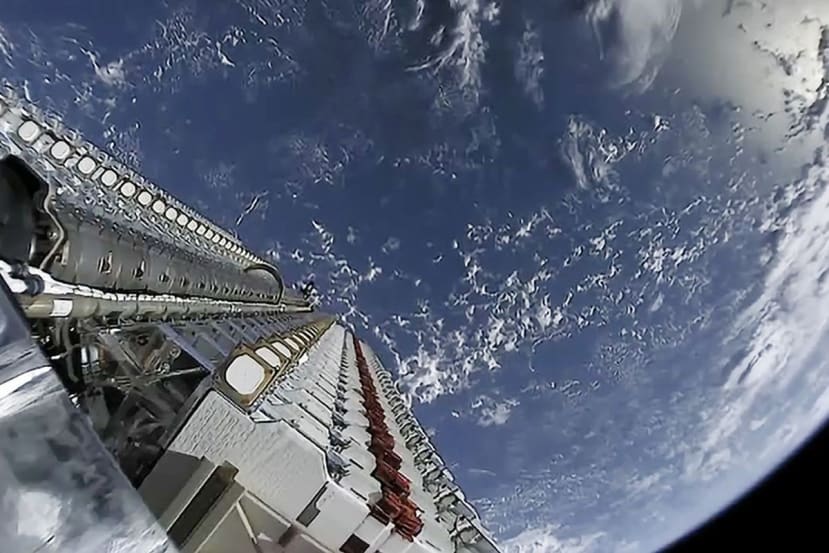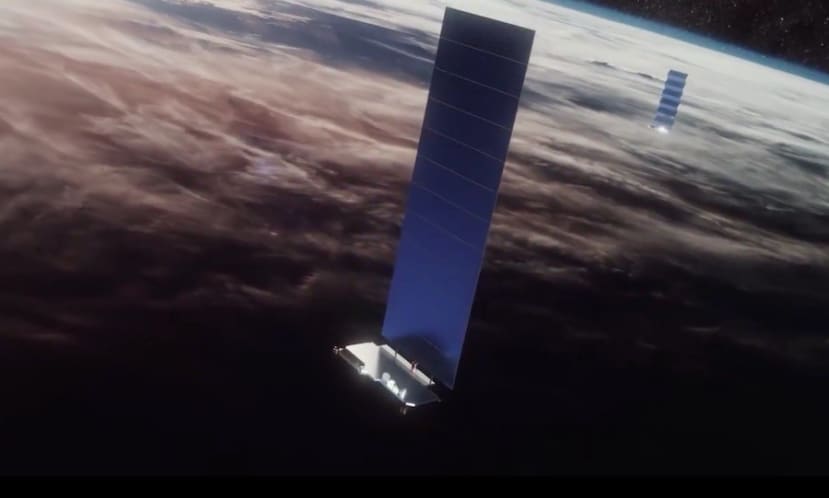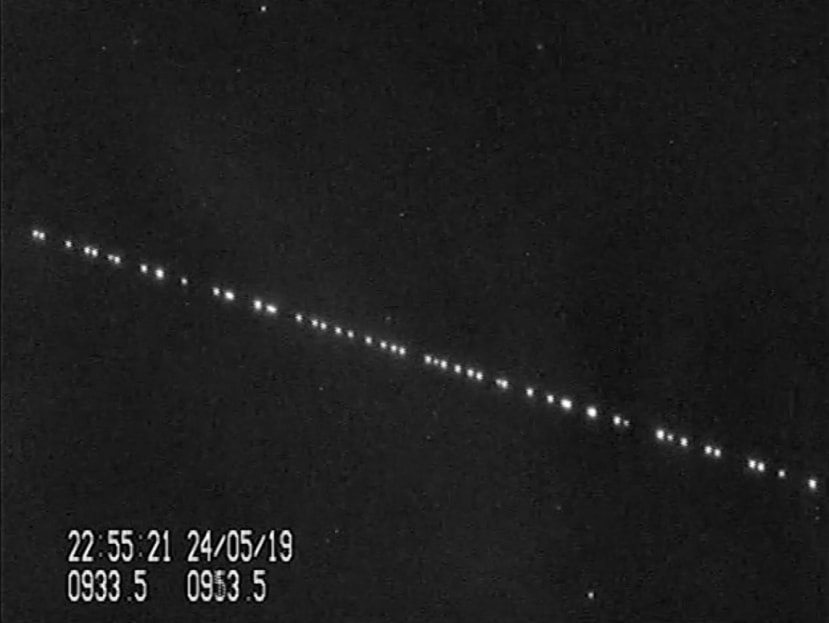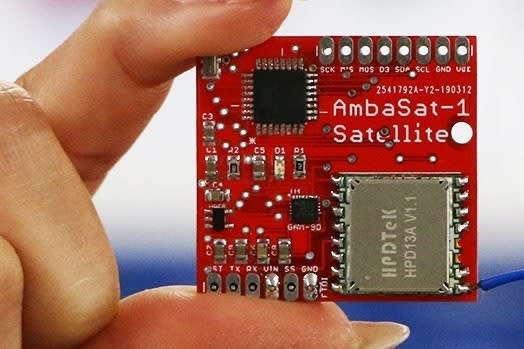New Constellations in the Sky
Follow articleHow do you feel about this article? Help us to provide better content for you.
Thank you! Your feedback has been received.
There was a problem submitting your feedback, please try again later.
What do you think of this article?
Initial 60 satellites for the Starlink constellation sit ready to be dispensed.
Credit: SpaceX
In the Beginning
Arthur C. Clarke wrote the seminal paper: “Extra-Terrestrial Relays — Can Rocket Stations Give Worldwide Radio Coverage?” in 1945 based on an idea for orbiting space stations first published in 1942. In his paper, Clarke outlined the principle of using just three satellites orbiting the Earth 22,236 miles above the equator to achieve world-wide communication coverage - the so-called Geostationary orbit. At that distance the satellite is moving at the same rate as the Earth is turning, meaning that the orbit is also Geosynchronous. It’s called Geostationary because a satellite placed at that distance will appear to a ground observer to be fixed at a particular point in the sky. Although a round-the-world communication relay service has actually been created with just three equally-spaced satellites, the orbit is now getting very congested with narrow beamwidth units serving only a single region of the Earth’s surface, for example, Northern Europe. Radio communication with a satellite that doesn’t appear to move is a lot easier than a Low-Earth Orbit (LEO) type that has to be tracked as it moves across the sky in minutes. But there is a complication.
Great if you live on the Equator
For the satellite to appear absolutely stationary in the sky, it must orbit around the equator. A receiver on the equator will ‘see’ the satellite directly overhead. The snag is that for receivers at higher latitudes the satellite appears lower in the sky as you move towards the poles. In northern Europe or Canada for example, the ground-based antenna is practically pointing to the horizon with all the interference caused by denser atmosphere, terrain and buildings that entails. A seemingly obvious solution is to tilt the orbit so the satellite is overhead at the desired latitude. Unfortunately, that orbit, while still geosynchronous is no longer geostationary and the satellite will appear to drift around on a ‘figure-of-eight’ track. Still, it will always be in view and a moveable antenna or one with wide enough beamwidth will ensure uninterrupted communication.
Geostationary satellites are expensive
They’re big, heavy and need their own propulsion system to get them from the low transfer orbit into which they are deposited by the booster rocket, to the distant operational orbit. That means a lot of fuel needs to be carried, both for the journey and for drift correction during its lifetime. The radio systems are power-hungry because of the distance from Earth which in turn means large solar arrays are needed. Then there’s the important issue of reliability. A geostationary satellite represents a large monetary investment all of which would be lost if it stops working in less than it’s predicted lifetime. Hence a great deal of effort goes into increasing the probability of ‘mission’ success by designing-in redundancy, adding environmental shielding and carrying out tough pre-launch testing. After all, premature system failure could lead to a whole region on Earth losing all its satellite TV channels! At the end of its life, it must be able to move into a ‘graveyard orbit’ to avoid cluttering up the working orbit with yet more ‘Space junk’.
Satellite Constellations
In 1998 the Iridium communication satellite constellation became operational in low Earth orbit. It consists of 66 units each acting as a node in a mesh network orbiting from pole-to-pole. Iridium provides world-wide sat-phone coverage and demonstrates that a ‘wireless network’ in Space is commercially viable. The polar orbit provides particularly good coverage at the North and South poles – just where a sat-phone is particularly useful! A new network to replace it, Iridium-NEXT is being set up with the first 10 units being launched in 2017. The satellites are still relatively large and expensive, but can only provide coverage for a limited number of relatively low-data-rate simultaneous ‘conversations’ because there are so few of them. For broadband Internet access, it looks like we need…
Mega-Constellations
Since Iridium began working, there has been a revolution in satellite technology bringing about massive reductions in spacecraft size and cost. We have miniature satellite formats such as CubeSat, PocketQube and now Sprite (see below). SpaceX has just launched 60 small satellites into low Earth orbit as a test run for a future ‘constellation’ containing as many as 12000. The Starlink project aims to create a cellular or mesh network in Space providing broadband Internet access for the whole world. Those 60 satellites were released into orbit from a ‘dispenser’ (see heading photo) carried aboard just one rocket.
Starlink satellite with solar array deployed.
Credit: SpaceX
The Upside of Constellations
A constellation operates much closer to Earth in orbits between 100 and 1200 miles out. A lot of satellites are needed to obtain adequate coverage, but it’s viable because:
- Propulsion is limited to minor orbit-changing and station keeping.
- Far less transmitter power is needed.
- Shorter distances mean less communication latency or ‘Sat-Lag’.
- Individual reliability is less important - a mesh network is inherently fault tolerant.
- Inactive ‘spares’ can be kept in orbit and moved when needed.
The Downside
There are two main issues: one that has been addressed at the design stage, the other somewhat unexpected.
- The question of over-crowded orbits and ‘Space-Junk’.
- Astronomers upset by a night sky covered in flashing white lights.
The degree to which the Space around the Earth is becoming one large junkyard is a hot topic at the moment. Any new object destined for orbit must either operate at a low enough altitude to re-enter the atmosphere and burn up automatically when its mission is completed or contain a mechanism to force a de-orbit when required.
Soon after the Iridium satellites were put into orbit, ground observers noticed a curious phenomenon – flashes of light in the sky which became known as Iridium Flares. They are caused by sunlight reflecting off their solar panels. It can happen with any satellite, but a constellation of identical satellites made it much more obvious. Nobody was too upset about it and eventually, flare-spotting became a common star-gazing activity. Sadly for some, their replacements, the new Iridium-NEXT satellites do not flare. However, a constellation of thousands of flaring satellites is a whole different problem which could disrupt Earth-bound astronomy.
Starlink satellites visible just after being dispensed
Credit: SatTrackCam
SpaceX claims it won’t be an issue once the Starlink satellites are in their operational positions. We shall see.
Sprite Constellations
A KickSat-2 Sprite satellite.
Credit: Cornell University
Last March the shrinking size of space satellites reached PCB level as 105 ‘Sprites’ were dispensed into orbit from a 3U CubeSat called KickSat-2. Ground communication was successful before they de-orbited after three days.
KickSat-2 dispensing Sprite PCB satellites into orbit.
Credit: Cornell University
A constellation of such tiny and vulnerable satellites may actually have a practical application. Obviously, they’re not powerful or reliable enough for broadband Internet networks, but they could be just the thing for short-life scientific research projects. For example, an array of Sprites with radios tuned to receive signals from a distant object in Space could be set up to function as a giant radio telescope on Earth. Measurements could be taken, results beamed to the ground and the Sprites de-orbited.
Fly your own spacecraft in a constellation
Fancy a chance to build and fly your own Sprite? I came across this AmbaSat-1 Satellite project on Kickstarter the other day. The Arduino-based satellites will attempt to communicate with the LoRaWAN-driven Things Network on the ground after being ‘dispensed’ in the same way as the KickSat Sprites.
An AmbaSat Sprite: 1 of 200 seeking backing on Kickstarter.
If all goes according to plan, the constellation will de-orbit after 3 months.
Finally
These PCB Sprites are impressive, but things are moving on. Researchers at the University of California (UCSB) are working on a spacecraft based on a single semiconductor wafer. These centimetre-sized Waferscale spacecraft will feature cameras, sensors and thrusters and form the heart of the Breakthrough Starshot project to send probes to our nearest star, Alpha Centauri.
If you're stuck for something to do, follow my posts on Twitter. I link to interesting articles on new electronics and related technologies, retweeting posts I spot about robots, space exploration and other issues.





